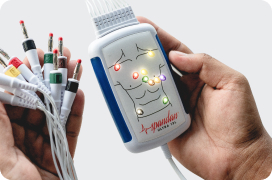
Author:- Mr. Ritesh Sharma
The world of cardiology is vast and intricate, with numerous diagnostic tools and indicators that aid in understanding and managing heart health. One such significant indicator is the epsilon wave ECG. Recognized for its role in diagnosing certain heart conditions, the epsilon wave ECG is a critical element that cardiologists closely monitor. In this blog, we will delve deep into the epsilon wave ECG, its significance, interpretation, and the conditions it helps diagnose.
What is an Epsilon Wave ECG?
An epsilon wave ECG refers to a specific pattern observed in the electrocardiogram (ECG) that indicates abnormal electrical activity within the heart. The epsilon wave is a small deflection, typically observed at the end of the QRS complex showcasing QRS complex abnormalities and before the onset of the T wave. It appears as a slight ‘blip’ or a positive deflection, mainly in the right precordial leads (V1 to V3) of the ECG.
Significance of Epsilon Wave ECG
The epsilon wave ECG holds significant clinical importance as it is most commonly associated with arrhythmogenic right ventricular dysplasia/cardiomyopathy (ARVD/C). ARVD/C is a rare but serious condition characterized by the replacement of the right ventricular myocardium with fatty and fibrous tissue, leading to cardiac arrhythmias and potentially sudden cardiac death. The presence of an epsilon wave on an abnormal ECG can be a vital clue in the early detection and diagnosis of this condition, allowing for timely intervention and management.
Identifying Epsilon Waves
Identifying an epsilon wave on an ECG requires a keen eye and thorough understanding of the heart’s electrical patterns. The epsilon wave is subtle and can often be mistaken for other minor deflections or noise. However, certain features can help in its identification:
- Location: Epsilon waves are primarily found in the right precordial leads (V1 to V3).
- Appearance: They appear as small, positive deflections following the QRS complex and before the T wave.
- Duration: Epsilon waves are typically brief, lasting only a few milliseconds.
Diagnostic Criteria Involving Epsilon Wave ECG
In the diagnosis of ARVD/C, the presence of an epsilon wave ECG is one of the major criteria. According to the Task Force Criteria for the diagnosis of ARVD/C, an epsilon wave on the ECG in the right precordial leads is a significant indicator. However, it is important to note that not all patients with ARVD/C will exhibit epsilon waves, and their absence does not rule out the condition. Therefore, the epsilon wave ECG is used in conjunction with other diagnostic tests, such as imaging studies and genetic testing, to confirm the diagnosis.
Epsilon Wave ECG and Differential Diagnosis
While the epsilon wave ECG is a hallmark of ARVD/C, it is crucial to consider other conditions that might mimic its appearance. These conditions include:
- Right ventricular outflow tract tachycardia (RVOT): A condition that causes arrhythmias originating from the right ventricular outflow tract.
- Brugada syndrome: A genetic disorder that leads to abnormal ECG findings and an increased risk of sudden cardiac death.
- Sarcoidosis: An inflammatory disease that can affect the heart and alter ECG patterns.
- Chronic obstructive pulmonary disease (COPD): Severe cases of COPD can cause changes in the right side of the heart, potentially mimicking epsilon waves.
Differentiating between these conditions is essential for accurate diagnosis and appropriate management.
Management and Treatment Based on Epsilon Wave ECG Findings
The detection of an epsilon wave on an ECG necessitates further investigation and a comprehensive evaluation of the patient’s heart health. If ARVD/C is suspected, several steps are typically taken:
- Imaging Studies: Cardiac MRI or echocardiography may be used to visualize structural changes in the heart.
- Genetic Testing: Since ARVD/C has a genetic component, testing for known mutations can aid in diagnosis.
- Electrophysiological Studies: These tests help in assessing the electrical function of the heart and identifying arrhythmias.
Once ARVD/C is confirmed, treatment focuses on managing symptoms and reducing the risk of sudden cardiac death. This may include:
- Medication: Antiarrhythmic drugs to control arrhythmias.
- Lifestyle Modifications: Avoiding strenuous physical activity to reduce the risk of arrhythmias.
- Implantable Cardioverter-Defibrillator (ICD): Insertion of an ICD device to monitor and correct abnormal heart rhythms.
Epsilon Wave ECG in Modern Cardiology
The field of cardiology continually evolves with advancements in technology and research. The epsilon wave ECG remains a cornerstone in the diagnosis of ARVD/C, but its interpretation and significance are continually refined. With better imaging techniques, genetic insights, and a deeper understanding of heart disease mechanisms, the role of epsilon waves in ECG has become even more crucial.
The epsilon wave ECG is a vital diagnostic tool that holds immense significance in identifying serious cardiac conditions like arrhythmogenic right ventricular dysplasia/cardiomyopathy. Recognizing this subtle deflection requires expertise and a thorough understanding of the heart’s electrical activity. While it serves as a major criterion for diagnosing ARVD/C, it is important to consider other potential conditions and conduct comprehensive evaluations. As cardiology advances, the role of epsilon waves in ECG continues to be a critical area of focus, guiding timely diagnosis and effective management of heart disease.
Understanding the nuances of the epsilon wave ECG can make a significant difference in patient outcomes, underscoring the importance of continual learning and awareness in the ever-evolving field of cardiology.




